AR
-
 International Workshop on Flexible Displays Held on Aug. 21-22
An international workshop on flexible displays will be held at KAIST on Aug. 21-22.
The workshop organized by Center for Advanced Flexible Display Convergence (CAFDC) in KAIST is designed to share ideas on the latest research developments and explore future trends in organic displays. Organic displays made from organic light-emitting diode (OLED) materials have recently made a real impact in consumer electronics and emerged as one of the most important technologies in the development of next-generation flexible displays.
"The workshop is expected to provide an important opportunity to showcase latest technological developments using organic light-emitting diode and examine them from the perspectives of the next-generation flexible display," said Dr. Kyung-Cheol Choi, KAIST professor of electrical engineering and computer science who heads the CAFDC.
The event will feature some of the world-renowned scholars in organic display including Prof. Stephen R. Forrest of the University of Michigan, Prof. Bernard Kippelen of Georgia Tech, and Prof. Takao Someya of the University of Tokyo, as theme presenters. It will also draw a slew of domestic scholars in the industry and academia.
2008.08.22 View 16843
International Workshop on Flexible Displays Held on Aug. 21-22
An international workshop on flexible displays will be held at KAIST on Aug. 21-22.
The workshop organized by Center for Advanced Flexible Display Convergence (CAFDC) in KAIST is designed to share ideas on the latest research developments and explore future trends in organic displays. Organic displays made from organic light-emitting diode (OLED) materials have recently made a real impact in consumer electronics and emerged as one of the most important technologies in the development of next-generation flexible displays.
"The workshop is expected to provide an important opportunity to showcase latest technological developments using organic light-emitting diode and examine them from the perspectives of the next-generation flexible display," said Dr. Kyung-Cheol Choi, KAIST professor of electrical engineering and computer science who heads the CAFDC.
The event will feature some of the world-renowned scholars in organic display including Prof. Stephen R. Forrest of the University of Michigan, Prof. Bernard Kippelen of Georgia Tech, and Prof. Takao Someya of the University of Tokyo, as theme presenters. It will also draw a slew of domestic scholars in the industry and academia.
2008.08.22 View 16843 -
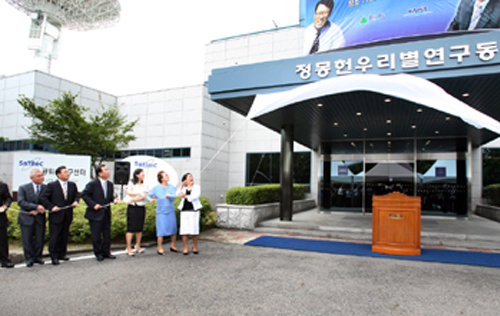 Satellite Research Lab Named After Late Hyundai Chairman Chung
KAIST, Aug. 11, 2008 -- KAIST held a naming ceremony for a research lab which was named after the late Hyundai Asan Chairman Mong-Hun Chung on Monday (Aug. 11) at the KAIST Satellite Technology Research Center.
During the ceremony, a seminar room was also named after Dr. Soon-dal Choi, President of Daeduk College, for his distinguished contributions to the development of Korean space science.
Back in 1992, the late chairman Chung donated 3.4 billion won (US$3.4 million) to KAIST to build a satellite laboratory for the development of core space technologies and the nurturing of skilled manpower.
The naming ceremony was held in commemoration of the 16th anniversary of the launch of Korea"s first small satellite "Uribyeol 1" on Aug. 11, 1992. Chung died in 2003.
Dr. Soon-Dal Choi who laid the ground work for Korea"s space development program, served as the inaugural director general of the KAIST Satellite Technology Research Center, the birthplace of Korea"s artificial satellite.
On hand at the naming ceremony were a slew of dignitaries including Jeong-Eun Hyun, Hyundai Group Chairwoman and wife of the late Chung; and about 10 chief executives of Hyundai Group companies; Seong-Hyo Park, Mayor of the Daejeon Metropolitan City; Ms. So-Yeon Lee, Korea"s first astronaut; and KAIST President Nam-Pyo Suh.
President Suh noted that late Chairman Chung made great contributions to Korea"s artificial satellite development with his donation to the satellite laboratory. He said Dr. Choi is the father of the nation"s satellite program who provided the vision of space development in Korea at a time when Korea lagged behind in the artificial satellite technology.
2008.08.12 View 17434
Satellite Research Lab Named After Late Hyundai Chairman Chung
KAIST, Aug. 11, 2008 -- KAIST held a naming ceremony for a research lab which was named after the late Hyundai Asan Chairman Mong-Hun Chung on Monday (Aug. 11) at the KAIST Satellite Technology Research Center.
During the ceremony, a seminar room was also named after Dr. Soon-dal Choi, President of Daeduk College, for his distinguished contributions to the development of Korean space science.
Back in 1992, the late chairman Chung donated 3.4 billion won (US$3.4 million) to KAIST to build a satellite laboratory for the development of core space technologies and the nurturing of skilled manpower.
The naming ceremony was held in commemoration of the 16th anniversary of the launch of Korea"s first small satellite "Uribyeol 1" on Aug. 11, 1992. Chung died in 2003.
Dr. Soon-Dal Choi who laid the ground work for Korea"s space development program, served as the inaugural director general of the KAIST Satellite Technology Research Center, the birthplace of Korea"s artificial satellite.
On hand at the naming ceremony were a slew of dignitaries including Jeong-Eun Hyun, Hyundai Group Chairwoman and wife of the late Chung; and about 10 chief executives of Hyundai Group companies; Seong-Hyo Park, Mayor of the Daejeon Metropolitan City; Ms. So-Yeon Lee, Korea"s first astronaut; and KAIST President Nam-Pyo Suh.
President Suh noted that late Chairman Chung made great contributions to Korea"s artificial satellite development with his donation to the satellite laboratory. He said Dr. Choi is the father of the nation"s satellite program who provided the vision of space development in Korea at a time when Korea lagged behind in the artificial satellite technology.
2008.08.12 View 17434 -
 Prof. Lee Appointed to Advisory Board of the U.S. Joint BioEnergy Institute
Prof. Sang-Yup Lee of the Department of Chemical and Biomolecular Engineering, KAIST, has been appointed as a member of the scientific advisory board of the Joint BioEnergy Institute under the wing of the U.S. Department of Energy, university authorities said on Monday (Aug. 4).
The Joint BioEnergy Institute (JBEI) is a scientific partnership in the San Francisco Bay area, California, led by Lawrence Berkeley National Laboratory (Berkeley Lab). Its partner organizations include the Sandia National Laboratories, the University of California in Berkeley, UC Davis, the Carnegie Institution for Science and the Lawrence Livermore National Laboratory.
JBEI
2008.08.07 View 13878
Prof. Lee Appointed to Advisory Board of the U.S. Joint BioEnergy Institute
Prof. Sang-Yup Lee of the Department of Chemical and Biomolecular Engineering, KAIST, has been appointed as a member of the scientific advisory board of the Joint BioEnergy Institute under the wing of the U.S. Department of Energy, university authorities said on Monday (Aug. 4).
The Joint BioEnergy Institute (JBEI) is a scientific partnership in the San Francisco Bay area, California, led by Lawrence Berkeley National Laboratory (Berkeley Lab). Its partner organizations include the Sandia National Laboratories, the University of California in Berkeley, UC Davis, the Carnegie Institution for Science and the Lawrence Livermore National Laboratory.
JBEI
2008.08.07 View 13878 -
 Home-Grown Transparent Thin Film Transistor Developed
KAIST, Aug. 6, 2008 -- A KAIST research team led by Profs. Jae-Woo Park and Seung-Hyup Yoo of the Electrical Engineering Division has developed a home-grown technology to create transparent thin film transistor using titanium dioxide., university authorities said.The KAIST team made the technological advance in collaboration with the LCD Division of Samsung Electronics and the Techno Semichem Co., a local LCD equipment maker. Transparent thin film transistor continues to enjoy a wealth of popularity and intensive research interest since it is used in producing operating circuits including transparent display, active-matrix OLED (AMOLED) display and flexible display.
The new technology is significant in that it is based on a titanium dioxide, the first such attempt in the world, while the technologies patented by the United States and Japan are based on ZnO.
Researchers will continue to work on securing technological reliability and developing a technology to mass-produce in a large-scale chemical vapor deposition equipment for the next couple of years.
"The development of technology to produce transparent thin film transistor will help Korean LCD makers reduce its dependence on foreign technologies, as well as maintain Korea"s status as a leader of the world"s display industry," said Prof. Park.
KAIST has applied for local patent registration of the technology and the process is expected to complete by this October or November. International patents have been also applied for in the U.S., Japan and Europe.
The new technology was introduced in the latest edition of the Electron Device Letters, a journal published by the Institute of Electrical and Electronics Engineers or IEEE, a New York-based international non-profit, professional organization for the advancement of technology related to electricity. It will be presented at the International Display Workshop 2008 on Dec. 5 in Niigata, Japan.
2008.08.07 View 17071
Home-Grown Transparent Thin Film Transistor Developed
KAIST, Aug. 6, 2008 -- A KAIST research team led by Profs. Jae-Woo Park and Seung-Hyup Yoo of the Electrical Engineering Division has developed a home-grown technology to create transparent thin film transistor using titanium dioxide., university authorities said.The KAIST team made the technological advance in collaboration with the LCD Division of Samsung Electronics and the Techno Semichem Co., a local LCD equipment maker. Transparent thin film transistor continues to enjoy a wealth of popularity and intensive research interest since it is used in producing operating circuits including transparent display, active-matrix OLED (AMOLED) display and flexible display.
The new technology is significant in that it is based on a titanium dioxide, the first such attempt in the world, while the technologies patented by the United States and Japan are based on ZnO.
Researchers will continue to work on securing technological reliability and developing a technology to mass-produce in a large-scale chemical vapor deposition equipment for the next couple of years.
"The development of technology to produce transparent thin film transistor will help Korean LCD makers reduce its dependence on foreign technologies, as well as maintain Korea"s status as a leader of the world"s display industry," said Prof. Park.
KAIST has applied for local patent registration of the technology and the process is expected to complete by this October or November. International patents have been also applied for in the U.S., Japan and Europe.
The new technology was introduced in the latest edition of the Electron Device Letters, a journal published by the Institute of Electrical and Electronics Engineers or IEEE, a New York-based international non-profit, professional organization for the advancement of technology related to electricity. It will be presented at the International Display Workshop 2008 on Dec. 5 in Niigata, Japan.
2008.08.07 View 17071 -
 KAIST Professor Named International Research Grant Reviewer
Prof. Kwang-Hyun Cho of the Department of Bio and Brain Engineering, KAIST, was appointed as a research grant review committee member of the international Human Frontier Science Program (HFSP) for 2008-2009, university authorities reported.
The HFSP is a funding agency that supports international collaboration in interdisciplinary, basic research in the life sciences. It was initiated in 1989 by G7 countries as the sole funding program for international researches in neuroscience and molecular biology. The HFSP now has a membership of 35 countries and Korea joined the program in 2004. Prof. Cho will be responsible for reviewing grant applications in the field of systems biology.
Prof. Cho received B.S., M.S. and Ph.D. degrees in electrical engineering from KAIST in 1993, 1995, and 1998, respectively. He has been working as a director of the KAIST Institute for the BioCentury and KAIST"s Laboratory for Systems Biology and Bio-Inspired Engineering. He has been serving on editorial advisory boards of various international science journals, including Systems and Synthetic Biology (Springer, Netherlands, from 2006), BMC Systems Biology (BMC, London, U.K., from 2007) and Gene Regulation and Systems Biology (Libertas Academica, New Zealand, from 2007).
He is a senior member of the Engineering in Medicine and Biology Society (EMBS) affiliated with the Institute of Electronics and Electrical Engineers (IEEE). His research interests cover the areas of systems science with bio-medical applications, especially systems biology and bio-inspired engineering based on molecular systems biology.
2008.07.18 View 20864
KAIST Professor Named International Research Grant Reviewer
Prof. Kwang-Hyun Cho of the Department of Bio and Brain Engineering, KAIST, was appointed as a research grant review committee member of the international Human Frontier Science Program (HFSP) for 2008-2009, university authorities reported.
The HFSP is a funding agency that supports international collaboration in interdisciplinary, basic research in the life sciences. It was initiated in 1989 by G7 countries as the sole funding program for international researches in neuroscience and molecular biology. The HFSP now has a membership of 35 countries and Korea joined the program in 2004. Prof. Cho will be responsible for reviewing grant applications in the field of systems biology.
Prof. Cho received B.S., M.S. and Ph.D. degrees in electrical engineering from KAIST in 1993, 1995, and 1998, respectively. He has been working as a director of the KAIST Institute for the BioCentury and KAIST"s Laboratory for Systems Biology and Bio-Inspired Engineering. He has been serving on editorial advisory boards of various international science journals, including Systems and Synthetic Biology (Springer, Netherlands, from 2006), BMC Systems Biology (BMC, London, U.K., from 2007) and Gene Regulation and Systems Biology (Libertas Academica, New Zealand, from 2007).
He is a senior member of the Engineering in Medicine and Biology Society (EMBS) affiliated with the Institute of Electronics and Electrical Engineers (IEEE). His research interests cover the areas of systems science with bio-medical applications, especially systems biology and bio-inspired engineering based on molecular systems biology.
2008.07.18 View 20864 -
 KAIST to hold 2008 Int
KAIST, Korea"s premier science and technology research university, will hold the 1st International Presidential Forum on Global Research Universities at the Westin Chosun Hotel in Seoul on Sept. 8, 2008. Presidents of research universities in all regions of the world have been invited to the conference aimed primarily at identifying common issues and opportunities in strengthening globalization of higher education and research.
Participants in the forum will exchange views and ideas on how to build and utilize global research network to promote the sharing of expertise and facilities, conduct joint researches and effectively implement dual degree and roaming professorship programs.
KAIST President Dr. Nam P. Suh said of the purpose of the conference: "Research universities have become global enterprises. Collaborations that were once primarily between individual researchers are now increasingly occurring at institutional and international levels. Similarly, educating students which used to be the responsibility of a single university has now become a multi-institutional undertaking, involving many universities in different countries.
"Now leading research universities in many countries depend on the continuous supply of outstanding graduate students form the "feeder" schools of developing nations. There are concerns that the current system may not be serving the interest and need of some institutions, especially those in developing nations. This should be examined and understood to devise international mechanisms that can accentuate the positive aspects of globalization.
"Through this forum, we hope to forge an international network of universities that will strengthen the effort of individual universities and create alliances for research and education that can become a new paradigm for global collaboration."
Keynote presentations will be made on the following five major subjects: -- Roaming Professorship-- Dual Degree Program-- Sharing Facilities and Expertise-- Joint Research, and-- Globalization through Interfacing with Existing Networking
Leaders of the world"s major education and research institutions have been asked to lead panel discussions with their rich experiences in globalization programs.
Following the conference in Seoul, participants are invited to come to the KAIST campus in Daejeon, about 150 kilometers from Seoul, where a symposium on EEWS (environment, energy, water and sustainability) will be held to examine the progress in interdisciplinary research activities in these vital problems facing the mankind and look for a new direction in international collaboration.
Co-sponsors of the International Presidential Forum include the Dong-A Ilbo, a major national daily, and the Dong-A Science Magazine.
Message from KAIST President Suh:
Research universities have become global enterprises. Collaborations that were once primarily between individual researchers are now increasingly occurring at institutional and international levels. Similarly, educating students used to be the responsibility of a single university but has now become a multiinstitutional undertaking, involving many universities in different countries.
These changes are a consequence of globalization and integration of the world’s economy. Temporal andgeographical separations are no longer barriers to the collective generation and transfer of knowledge andenlightened education. It is also a natural response to the demand for educated workforce who can functionin any country.
Current globalization was preceded by the migration of graduate students who were seeking to fulfill theiraspirations for better education at the world’s leading universities. This international movement of studentshas benefited not only students but research universities as well. Now leading research universities in manycountries depend on the continuous supply of outstanding graduate students from the “feeder” schools ofdeveloping nations.
There are some concerns that the current system may not be serving the interest and need of some institutions,especially those in developing nations. This should be examined and understood to devise institutionalmechanisms that can accentuate the positive aspects of globalization.
The purpose of the International Forum of Research University Presidents, which will be held on Sept. 8 inSeoul, Korea, is to identify common issues and opportunities for research universities that further strengthenglobalization of higher education and research. Participants will hear diverse views and ideas and will learnfrom those who have been active in global education and research. Participants also will examine dualdegree programs that are already in place among many universities and the effective implementation of aglobal research network.
Through this process, we hope to forge an international network of universities that will strengthen the effortof individual universities and create alliances for research and education that can become a new paradigm forglobal collaboration.
Looking forward to meeting you in Seoul,
Prof. Nam P. SuhPresidentKAIST
Tentative Program(Theme: Global Science and Technology Networking)
Sept. 7, 2008, Sunday 17:00 - 18:30 RegistrationSept. 8, 2008, Monday09:00 - 09:10 Opening Ceremony09:10 - 09:40 I. Keynote Presentation: Roaming Professorship09:40 - 10:20 Panel Presentations:- Improving the competitiveness of global university education- Sharing differences in culture and environment for sustainable education for the future generation- Promoting science and engineering education among secondary students- Preserving and utilizing expert knowledge for better education10:20 - 10:40 Open Discussion10:40 - 11:00 Coffee Break11:00 - 11:30 II. Keynote Presentation: Dual Degree Program11:30 - 12:10 Panel Presentations:- Benefits of dual degree program- The role of dual degree program easing brain drain- Global branch campus or dual degree program?- Raising international IQs of scientists and engineers for global enterprises12:10 - 12:30 Open Discussion12:30 - 14:00 Luncheon14:00 - 14:30 III. Keynote Presentation: Sharing Facilities and Expertise14:30 - 15:10 Panel presentations:- How to spin off international joint ventures from the sharing of research facilities and expertise- Economic benefits of sharing research facilities and expertise- How to communicate science and technology agenda to political leaders- Easing the gap between the developed and less developed regions through science and technology cooperation15:10 - 15:30 Open Discussion15:30 - 16:00 IV. Keynote Presentation: Joint Research16:00 - 16:40 Panel Presentations:- Benefits of international joint project- Ways to formulate the international joint projects- Sharing intellectual property rights- Global economic and social contributions of international joint project cooperation16:40 - 17:00 Open Discussion17:00 - 17:30 Coffee Break17:30 - 18:00 V. Keynote Presentation: Globalization through Interfacing with Existing Networking18:00 - 18:40 Panel Presentations:- Establishing global science and technology networking- The role of global science and technology networking for the higher education of the next century- Regionalized or globalized science and technology networking- Connecting regional science and technology networks for the global networking18:40 - 19:00 Open Discussion19:00 - 19:15 Closing Remarks by President Suh19:15 - 21:30 Banquet
Venue: Westin Chosun Hotel, Seoul
2008.07.17 View 20720
KAIST to hold 2008 Int
KAIST, Korea"s premier science and technology research university, will hold the 1st International Presidential Forum on Global Research Universities at the Westin Chosun Hotel in Seoul on Sept. 8, 2008. Presidents of research universities in all regions of the world have been invited to the conference aimed primarily at identifying common issues and opportunities in strengthening globalization of higher education and research.
Participants in the forum will exchange views and ideas on how to build and utilize global research network to promote the sharing of expertise and facilities, conduct joint researches and effectively implement dual degree and roaming professorship programs.
KAIST President Dr. Nam P. Suh said of the purpose of the conference: "Research universities have become global enterprises. Collaborations that were once primarily between individual researchers are now increasingly occurring at institutional and international levels. Similarly, educating students which used to be the responsibility of a single university has now become a multi-institutional undertaking, involving many universities in different countries.
"Now leading research universities in many countries depend on the continuous supply of outstanding graduate students form the "feeder" schools of developing nations. There are concerns that the current system may not be serving the interest and need of some institutions, especially those in developing nations. This should be examined and understood to devise international mechanisms that can accentuate the positive aspects of globalization.
"Through this forum, we hope to forge an international network of universities that will strengthen the effort of individual universities and create alliances for research and education that can become a new paradigm for global collaboration."
Keynote presentations will be made on the following five major subjects: -- Roaming Professorship-- Dual Degree Program-- Sharing Facilities and Expertise-- Joint Research, and-- Globalization through Interfacing with Existing Networking
Leaders of the world"s major education and research institutions have been asked to lead panel discussions with their rich experiences in globalization programs.
Following the conference in Seoul, participants are invited to come to the KAIST campus in Daejeon, about 150 kilometers from Seoul, where a symposium on EEWS (environment, energy, water and sustainability) will be held to examine the progress in interdisciplinary research activities in these vital problems facing the mankind and look for a new direction in international collaboration.
Co-sponsors of the International Presidential Forum include the Dong-A Ilbo, a major national daily, and the Dong-A Science Magazine.
Message from KAIST President Suh:
Research universities have become global enterprises. Collaborations that were once primarily between individual researchers are now increasingly occurring at institutional and international levels. Similarly, educating students used to be the responsibility of a single university but has now become a multiinstitutional undertaking, involving many universities in different countries.
These changes are a consequence of globalization and integration of the world’s economy. Temporal andgeographical separations are no longer barriers to the collective generation and transfer of knowledge andenlightened education. It is also a natural response to the demand for educated workforce who can functionin any country.
Current globalization was preceded by the migration of graduate students who were seeking to fulfill theiraspirations for better education at the world’s leading universities. This international movement of studentshas benefited not only students but research universities as well. Now leading research universities in manycountries depend on the continuous supply of outstanding graduate students from the “feeder” schools ofdeveloping nations.
There are some concerns that the current system may not be serving the interest and need of some institutions,especially those in developing nations. This should be examined and understood to devise institutionalmechanisms that can accentuate the positive aspects of globalization.
The purpose of the International Forum of Research University Presidents, which will be held on Sept. 8 inSeoul, Korea, is to identify common issues and opportunities for research universities that further strengthenglobalization of higher education and research. Participants will hear diverse views and ideas and will learnfrom those who have been active in global education and research. Participants also will examine dualdegree programs that are already in place among many universities and the effective implementation of aglobal research network.
Through this process, we hope to forge an international network of universities that will strengthen the effortof individual universities and create alliances for research and education that can become a new paradigm forglobal collaboration.
Looking forward to meeting you in Seoul,
Prof. Nam P. SuhPresidentKAIST
Tentative Program(Theme: Global Science and Technology Networking)
Sept. 7, 2008, Sunday 17:00 - 18:30 RegistrationSept. 8, 2008, Monday09:00 - 09:10 Opening Ceremony09:10 - 09:40 I. Keynote Presentation: Roaming Professorship09:40 - 10:20 Panel Presentations:- Improving the competitiveness of global university education- Sharing differences in culture and environment for sustainable education for the future generation- Promoting science and engineering education among secondary students- Preserving and utilizing expert knowledge for better education10:20 - 10:40 Open Discussion10:40 - 11:00 Coffee Break11:00 - 11:30 II. Keynote Presentation: Dual Degree Program11:30 - 12:10 Panel Presentations:- Benefits of dual degree program- The role of dual degree program easing brain drain- Global branch campus or dual degree program?- Raising international IQs of scientists and engineers for global enterprises12:10 - 12:30 Open Discussion12:30 - 14:00 Luncheon14:00 - 14:30 III. Keynote Presentation: Sharing Facilities and Expertise14:30 - 15:10 Panel presentations:- How to spin off international joint ventures from the sharing of research facilities and expertise- Economic benefits of sharing research facilities and expertise- How to communicate science and technology agenda to political leaders- Easing the gap between the developed and less developed regions through science and technology cooperation15:10 - 15:30 Open Discussion15:30 - 16:00 IV. Keynote Presentation: Joint Research16:00 - 16:40 Panel Presentations:- Benefits of international joint project- Ways to formulate the international joint projects- Sharing intellectual property rights- Global economic and social contributions of international joint project cooperation16:40 - 17:00 Open Discussion17:00 - 17:30 Coffee Break17:30 - 18:00 V. Keynote Presentation: Globalization through Interfacing with Existing Networking18:00 - 18:40 Panel Presentations:- Establishing global science and technology networking- The role of global science and technology networking for the higher education of the next century- Regionalized or globalized science and technology networking- Connecting regional science and technology networks for the global networking18:40 - 19:00 Open Discussion19:00 - 19:15 Closing Remarks by President Suh19:15 - 21:30 Banquet
Venue: Westin Chosun Hotel, Seoul
2008.07.17 View 20720 -
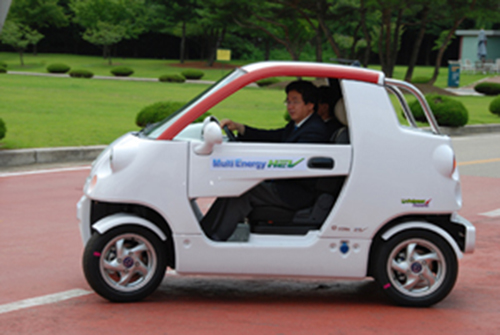 KAIST, CT&T Develop Multi-Energy Hybrid Electric Car
KAIST exchanged a memorandum of understanding for the development and production of a multi-energy plug-in hybrid electric car (ME-PHEV) with CT&T, an electric car maker, on Monday (June 30).
The ME-PHEV is a new vehicle model incorporating a small electric generator and solar energy as power source with conventional plug-in hybrid electric vehicle with rechargeable batteries. The new vehicle has been jointly developed by a research team led by Profs. Soon-Heung Chang and Yong-Hoon Chung, at the department of nuclear and quantum engineering, KAIST, and CT&T.
The ME-PHEV features an increased mileage, improved battery durability and better passenger convenience compared to conventional hybrid vehicles. The joint developers have applied for domestic and international patents.
Prior to the MOU signing ceremony, Prof. Chang, who is also a vice president of KAIST, had a trial ride of the vehicle for the media at the KAIST campus.
"Major car makers of the world currently focus on developing hybrid electric vehicles with battery and internal combustion engine. Compared to these cars, the ME-PHEV offers advantage in terms of reduced air pollution and lowered production costs," said Prof. Chang.
Under the agreement, CT&T will put the features of ME-PHEV into e-Zone, the company"s city-class, low-speed electric vehicle model, with a schedule go into commercial production of the car next year.
2008.07.02 View 17004
KAIST, CT&T Develop Multi-Energy Hybrid Electric Car
KAIST exchanged a memorandum of understanding for the development and production of a multi-energy plug-in hybrid electric car (ME-PHEV) with CT&T, an electric car maker, on Monday (June 30).
The ME-PHEV is a new vehicle model incorporating a small electric generator and solar energy as power source with conventional plug-in hybrid electric vehicle with rechargeable batteries. The new vehicle has been jointly developed by a research team led by Profs. Soon-Heung Chang and Yong-Hoon Chung, at the department of nuclear and quantum engineering, KAIST, and CT&T.
The ME-PHEV features an increased mileage, improved battery durability and better passenger convenience compared to conventional hybrid vehicles. The joint developers have applied for domestic and international patents.
Prior to the MOU signing ceremony, Prof. Chang, who is also a vice president of KAIST, had a trial ride of the vehicle for the media at the KAIST campus.
"Major car makers of the world currently focus on developing hybrid electric vehicles with battery and internal combustion engine. Compared to these cars, the ME-PHEV offers advantage in terms of reduced air pollution and lowered production costs," said Prof. Chang.
Under the agreement, CT&T will put the features of ME-PHEV into e-Zone, the company"s city-class, low-speed electric vehicle model, with a schedule go into commercial production of the car next year.
2008.07.02 View 17004 -
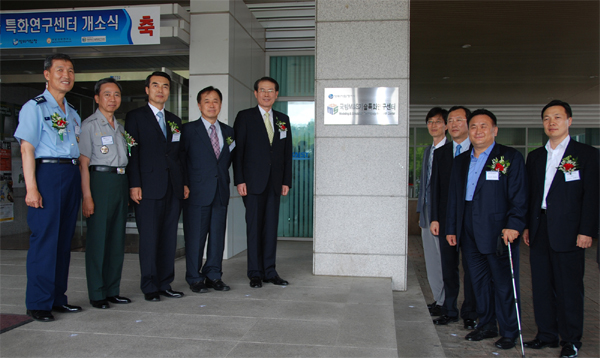 KAIST Opens M&S Technology Research Center
KAIST held an opening ceremony for a new defense research center focusing on modelling & simulation located at its main campus in Daejeon on Thursday (June 19).
The opening of the M&S Technology Research Center is aimed at developing technologies and processes to test, practice and operate newly-developed precision and micro weapons systems in virtual space. The center will be supported by two state-run defense agencies, the Defense Acquisition Program Administration and the Korean Agency for Defense Development.
The new research center is expected to receive a total of 11.5 billion won (US$11.2 million) research grants from the state for the next eight years until 2016. The center will be involved in the development of sophisticated, complex and inter-related weapons system and training research personnel in the specialized area.
The research center will undertake a total of 21 specific projects in collaboration with seven other universities in Korea. Also joining the projects are such overseas institutions as Georgia Institute of Technology and the U.S. Naval Post-Graduate School, and private defense solution providers including Posdata, Samsung Thales and LIG Nex 1.
The opening of the research center comes at a time when modelling and simulation gain growing importance as today"s armies employ more sophisticated, complex and inter-related. weapons systems and equipment than ever before.
Tae-Uk Lee, director of the research center said: "The opening of the center will spur development of operational technologies of precision and micro weapons system on our own, departing from dependence on advanced countries."
2008.06.19 View 18426
KAIST Opens M&S Technology Research Center
KAIST held an opening ceremony for a new defense research center focusing on modelling & simulation located at its main campus in Daejeon on Thursday (June 19).
The opening of the M&S Technology Research Center is aimed at developing technologies and processes to test, practice and operate newly-developed precision and micro weapons systems in virtual space. The center will be supported by two state-run defense agencies, the Defense Acquisition Program Administration and the Korean Agency for Defense Development.
The new research center is expected to receive a total of 11.5 billion won (US$11.2 million) research grants from the state for the next eight years until 2016. The center will be involved in the development of sophisticated, complex and inter-related weapons system and training research personnel in the specialized area.
The research center will undertake a total of 21 specific projects in collaboration with seven other universities in Korea. Also joining the projects are such overseas institutions as Georgia Institute of Technology and the U.S. Naval Post-Graduate School, and private defense solution providers including Posdata, Samsung Thales and LIG Nex 1.
The opening of the research center comes at a time when modelling and simulation gain growing importance as today"s armies employ more sophisticated, complex and inter-related. weapons systems and equipment than ever before.
Tae-Uk Lee, director of the research center said: "The opening of the center will spur development of operational technologies of precision and micro weapons system on our own, departing from dependence on advanced countries."
2008.06.19 View 18426 -
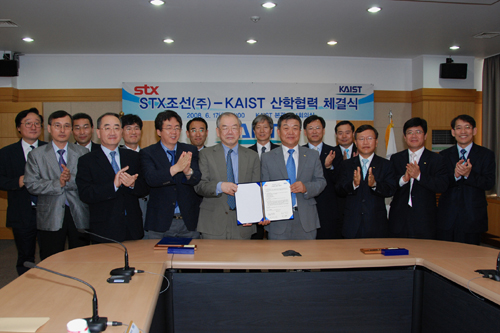 STX Shipbuilding Donates 500 Million won to KAIST
STX Shipbuilding Co, one of Korea"s leading shipbuilders, signed a memorandum of understanding with KAIST to donate 500 million won (about US$480,000) to Korea"s premier research university on Tuesday, June 17.
KAIST President Nam-Pyo Suh and STX Shipbuilding Vice Chairman In-Sung Lee signed the MOU in a ceremony at the KAIST attended by about 20 officials from the university and STX.
STX Shipbuilding donated the sum for the promotion of industrial-academia research projects at KAIST. It will be spent on supporting students" academic activities and scholarships, according to KAIST authorities.
At the signing ceremony, the two institutions also agreed to collaborate in the development of joint research projects and on-the-job training.
2008.06.18 View 12743
STX Shipbuilding Donates 500 Million won to KAIST
STX Shipbuilding Co, one of Korea"s leading shipbuilders, signed a memorandum of understanding with KAIST to donate 500 million won (about US$480,000) to Korea"s premier research university on Tuesday, June 17.
KAIST President Nam-Pyo Suh and STX Shipbuilding Vice Chairman In-Sung Lee signed the MOU in a ceremony at the KAIST attended by about 20 officials from the university and STX.
STX Shipbuilding donated the sum for the promotion of industrial-academia research projects at KAIST. It will be spent on supporting students" academic activities and scholarships, according to KAIST authorities.
At the signing ceremony, the two institutions also agreed to collaborate in the development of joint research projects and on-the-job training.
2008.06.18 View 12743 -
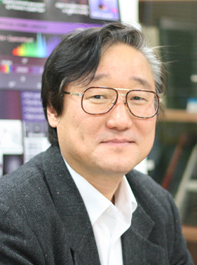 New System to Generate Extreme-Ultraviolet Light Developed
A KAIST research team led by Prof. Seung-Woo Kim of the Mechanical Engineering Department developed a new system for generating coherent extreme-ultraviolet (EUV) light, school authorities announced on June 5.
The new system comes in a metallic nano-structure consisting of a two-dimensional array of gold "bow tie" elements on a sapphire plate. The new process was featured in the British journal Nature on June 5.
The properties of coherent EUV light make it a prime candidate for exciting technological applications. But, at present, the equipment needed to generate the short-wavelength light is costly and bulky. The system developed by Prof. Kim"s research team is expected to reduce both cost and bulk.
The new system uses the conventional principle of high-harmonic generation via the interaction of a femtosecond laser pulse with a gas, but adopts the novel concept of amplifying light by way of local plasmon field enhancement, according to the research team.
2008.06.10 View 14909
New System to Generate Extreme-Ultraviolet Light Developed
A KAIST research team led by Prof. Seung-Woo Kim of the Mechanical Engineering Department developed a new system for generating coherent extreme-ultraviolet (EUV) light, school authorities announced on June 5.
The new system comes in a metallic nano-structure consisting of a two-dimensional array of gold "bow tie" elements on a sapphire plate. The new process was featured in the British journal Nature on June 5.
The properties of coherent EUV light make it a prime candidate for exciting technological applications. But, at present, the equipment needed to generate the short-wavelength light is costly and bulky. The system developed by Prof. Kim"s research team is expected to reduce both cost and bulk.
The new system uses the conventional principle of high-harmonic generation via the interaction of a femtosecond laser pulse with a gas, but adopts the novel concept of amplifying light by way of local plasmon field enhancement, according to the research team.
2008.06.10 View 14909 -
 Actress Han Makes Donation to KAIST
Actress and movie star Han Eunjung donated 100 million won ($98,000) to KAIST to help Korea"s prestigious research-oriented university continue its academic development on Wednesday (June 4).
In a donation ceremony held at the KAIST President"s office, she signed an agreement for donation.
Han said that she came to realize the importance of science and technology while filming a new movie based on a 15th century Joseon Dynasty episode featuring the development of a rocket-like firearm called "Singijeon." The blockbuster movie will be released in early August.
She also said that she was impressed by the first Korean astronaut So-Yeon Lee who took her undergraduate, master"s and doctorate degrees at KAIST, and decided to make a contribution to the school.
"I hope that I would be of any help in the development of KAIST in becoming one of the top research universities in the world," she said.
Han has been cast for the MBC drama "Lawyers of Korea" which will be aired starting from July.
2008.06.05 View 12494
Actress Han Makes Donation to KAIST
Actress and movie star Han Eunjung donated 100 million won ($98,000) to KAIST to help Korea"s prestigious research-oriented university continue its academic development on Wednesday (June 4).
In a donation ceremony held at the KAIST President"s office, she signed an agreement for donation.
Han said that she came to realize the importance of science and technology while filming a new movie based on a 15th century Joseon Dynasty episode featuring the development of a rocket-like firearm called "Singijeon." The blockbuster movie will be released in early August.
She also said that she was impressed by the first Korean astronaut So-Yeon Lee who took her undergraduate, master"s and doctorate degrees at KAIST, and decided to make a contribution to the school.
"I hope that I would be of any help in the development of KAIST in becoming one of the top research universities in the world," she said.
Han has been cast for the MBC drama "Lawyers of Korea" which will be aired starting from July.
2008.06.05 View 12494 -
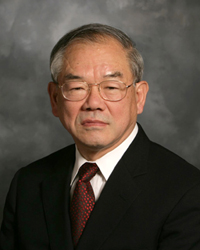 President Suh to Receive Honorary Doctorate from Carnegie Mellon University
Carnegie Mellon University of the United States has decided to present an honorary doctorate degree to KAIST President Nam-Pyo Suh, school authorities said on April 30.
President Suh will receive the honorary degree during the university"s 111th commencement ceremony at its Pittsburgh campus on May 18. Suh earned his Ph.D. in mechanical engineering at Carnegie Mellon in 1964.
Carnegie Mellon University said in a press release that Suh is honored for transforming KAIST into a world-class institution since he became president of KAIST in 2006.
"His distinguished academic career has also included posts at the University of South Carolina and the Massachusetts Institute of Technology, as well as an assistant directorship for the National Science Foundation of the United States. Beyond his academic leadership, Suh invented an industrial process for production of plastic parts that is used in factories worldwide. He holds more than 50 patents and helped start several companies," the press release said.
Five other prominent Americans will also receive honorary doctorate degrees from Carnegie Mellon along with President Suh. They are Al Gore, former U.S. vice president; Norman R. Augustine, former president and CEO of Martin-Marietta and Lockheed Martin and chairman of the American Red Cross; Jeff Bezos, founder of Amazon.com, the world"s largest online retailer; Elizabeth Catlett, an artist and sculptor famed for her dedication to the rights of minorities and women; and Patrick Colonel Suppes, a professor emeritus at Stanford University.
Carnegie Mellon, a leading research university of the United States is known for its distinctive mix of programs in engineering, computer science, robotics, business, public policy, fine arts and the humanities.
2008.04.30 View 14434
President Suh to Receive Honorary Doctorate from Carnegie Mellon University
Carnegie Mellon University of the United States has decided to present an honorary doctorate degree to KAIST President Nam-Pyo Suh, school authorities said on April 30.
President Suh will receive the honorary degree during the university"s 111th commencement ceremony at its Pittsburgh campus on May 18. Suh earned his Ph.D. in mechanical engineering at Carnegie Mellon in 1964.
Carnegie Mellon University said in a press release that Suh is honored for transforming KAIST into a world-class institution since he became president of KAIST in 2006.
"His distinguished academic career has also included posts at the University of South Carolina and the Massachusetts Institute of Technology, as well as an assistant directorship for the National Science Foundation of the United States. Beyond his academic leadership, Suh invented an industrial process for production of plastic parts that is used in factories worldwide. He holds more than 50 patents and helped start several companies," the press release said.
Five other prominent Americans will also receive honorary doctorate degrees from Carnegie Mellon along with President Suh. They are Al Gore, former U.S. vice president; Norman R. Augustine, former president and CEO of Martin-Marietta and Lockheed Martin and chairman of the American Red Cross; Jeff Bezos, founder of Amazon.com, the world"s largest online retailer; Elizabeth Catlett, an artist and sculptor famed for her dedication to the rights of minorities and women; and Patrick Colonel Suppes, a professor emeritus at Stanford University.
Carnegie Mellon, a leading research university of the United States is known for its distinctive mix of programs in engineering, computer science, robotics, business, public policy, fine arts and the humanities.
2008.04.30 View 14434